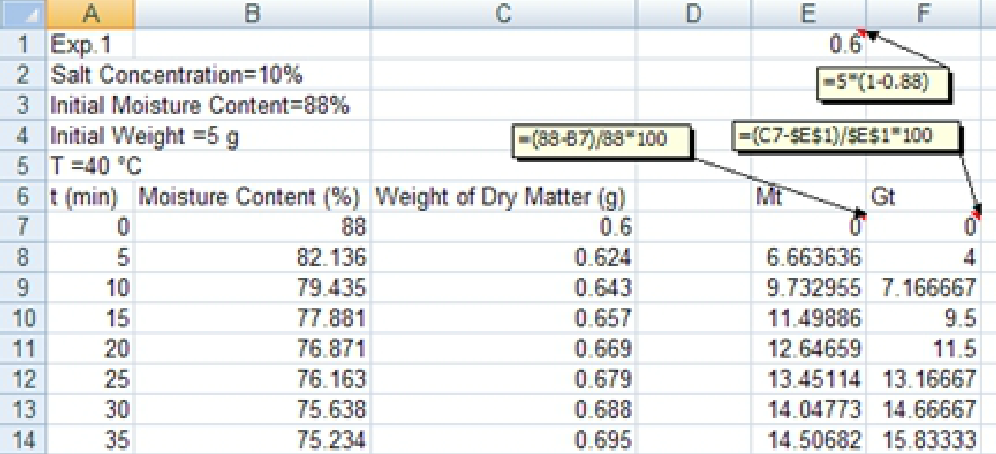Goal: When you have finished this laboratory exercise you will understand
- the osmotic drying process
and you will learn to
- to model the kinetics of moisture loss and solid gain by onion slices dried using different concentrations of salt solution at selected temperatures.
-
Osmotic dehydration has been widely proposed to improve the quality (softened texture, enhanced natural flavor and color retention) of dried food products with correct choice of solute type and concentration, soaking time and temperature.
Most common solute types used for this purpose are sugars - sucrose (mainly for fruits) and salts - sodium chloride (for vegetables, fish and meat).
In most osmotic dehydration processes, osmosis is carried out at constant temperature.
A typical osmotic dehydration process requires several hours for moisture loss and solids gain by the food material to reach an equilibrium state.
-
Fresh good quality dark-pink onions will be used in the experiments.
The onions after peeling will be cut into 4mm thick slices using a sharp kitchen knife, and the moisture content of the onions will be determined by a vacuum oven drying method.
NaCl solutions will be prepared in 5, 10 and 15% (w/v) by dissolving required amount of salt in distilled water. Then, the onion slices will be immersed in the NaCl solutions (involving 0.2% potassium metabisulphite to prevent pink discoloration of the dried onions) kept at given temperature (30, 40 and 50oC). The osmotic solution will be agitated gently through the entire dehydration process. -
The onion sample-to-solution ratio will be kept at 1:5 in all experiments, and moisture loss and solid gain of the onion slices will be calculated from the moisture and weight change of the slices in 5 mins intervals.
The moisture content change of the slices will be again measured by vacuum oven drying method, and the increase in dry matter will be noted as solid or salt gain.
Experiments will be conducted at nine combinations, 3 NaCl concentrations (5,10 and 15%) and 3 temperatures (30, 40 and 50oC).
-
Osmotic dehydration is a typical solid-liquid contact process where the removal of water from a solid food is accomplished by immersion in a concentrated aqueous solution.
The driving force for water removal is the osmotic pressure difference between the food material and its surrounding medium.
In most osmotic dehydration processes, osmosis is carried out at constant concentration of solution and temperature leading to moisture loss and solid gain by the food material as a function of time. -
In this experiment, we will use onion slices and salt (sodium chloride - NaCl) solutions for an osmotic dehydration process and measure the moisture loss and solid gain by onion slices to determine the required parameters to control and optimize an osmotic dehydration process.
For this purpose, a two parameter model, developed by Azura et al. (2002) will be applied to the experimental data.
For moisture loss:
-
For solid gain:

The data analysis part will include a mathematical approach to determine the required model parameters for these equations.
-
In this laboratory exercise, you obtained data on change in the moisture content and solid gain of onions immersed in NaCl solutions at a constant temperature.
We will use a two parameter model for moisture loss and solid gain to describe the mass transfer phenomenon during this osmotic dehydration process.
For moisture loss:
For solid gain:

Using these equations, we will determine the constants related to the moisture loss and solid gain. For this purpose:
-
1. Determine the Mt and Gt values from the experimental data using the following equations (see the figure):


-
2. Using the changes in the moisture loss and solid gain fractions, determine the S and G values using the linear forms of the given equations:

For both cases, the plot of t/Mt or t/Gt versus t is required where the slopes will lead to the G values while the intercept will lead to the S values.
The Treand option can be applied for this purpose: -

- How did S1, S2, G∞ and ∞ values change with temperature and salt concentration? Discuss the observed trends.
- Would you expect an increase in solid gain or in moisture loss with increasing concentration of osmotic solution or temperature? Why?
- What would be the effect of temperature during osmotic dehydration with respect to the changes in the solution and drying material?
- Azura, E., Cortes, R., Garcia, H.S. and Berstian, C.I. (1992). Kinetic model for osmotic dehydration and its relationship with Fick's second law. Int. J. Food Sci. Tech. 27:239-242.
- Monnerat, S.M., Pizzi, T.R.M., Mauro, M.A. and Menegallo, F.C. (2006). Concentration profiles and elective diffusion coefficient of sucrose and water in osmo-dehydrated apples. Food Res. Int. 39: 739-748.
- Sereno, A.M., Moreira, R. and Martinez, E. (2001). Mass transfer coefficients during osmotic dehydration of apple in single and combined aqueous solutions of sugar and salt. J. Food Eng. 47: 43-49.